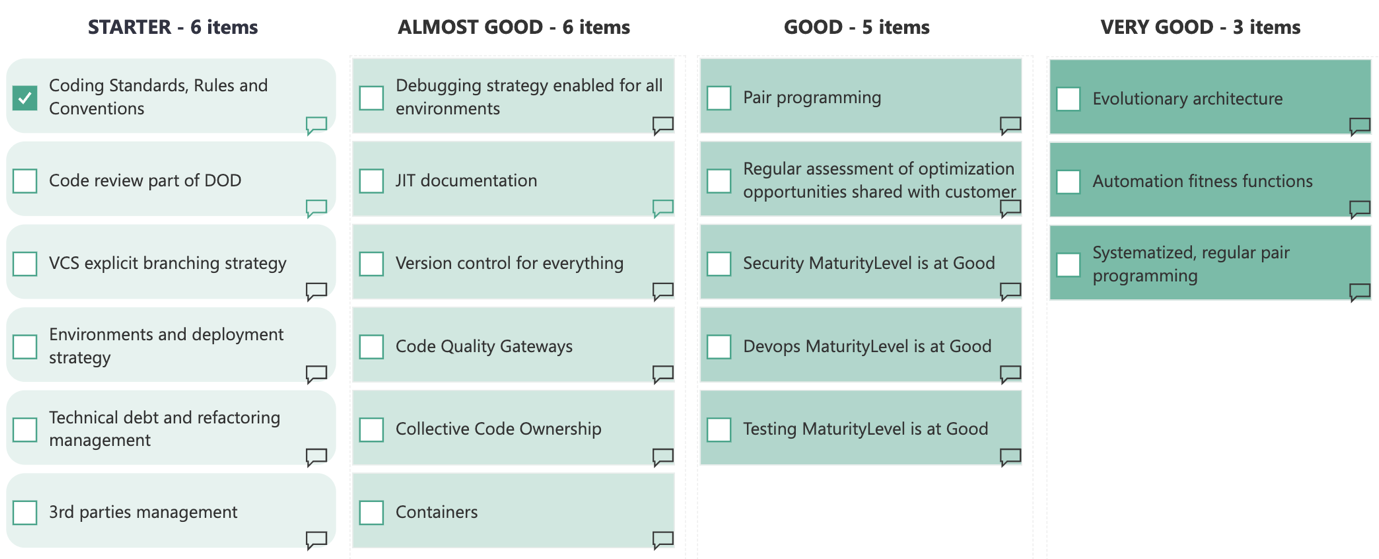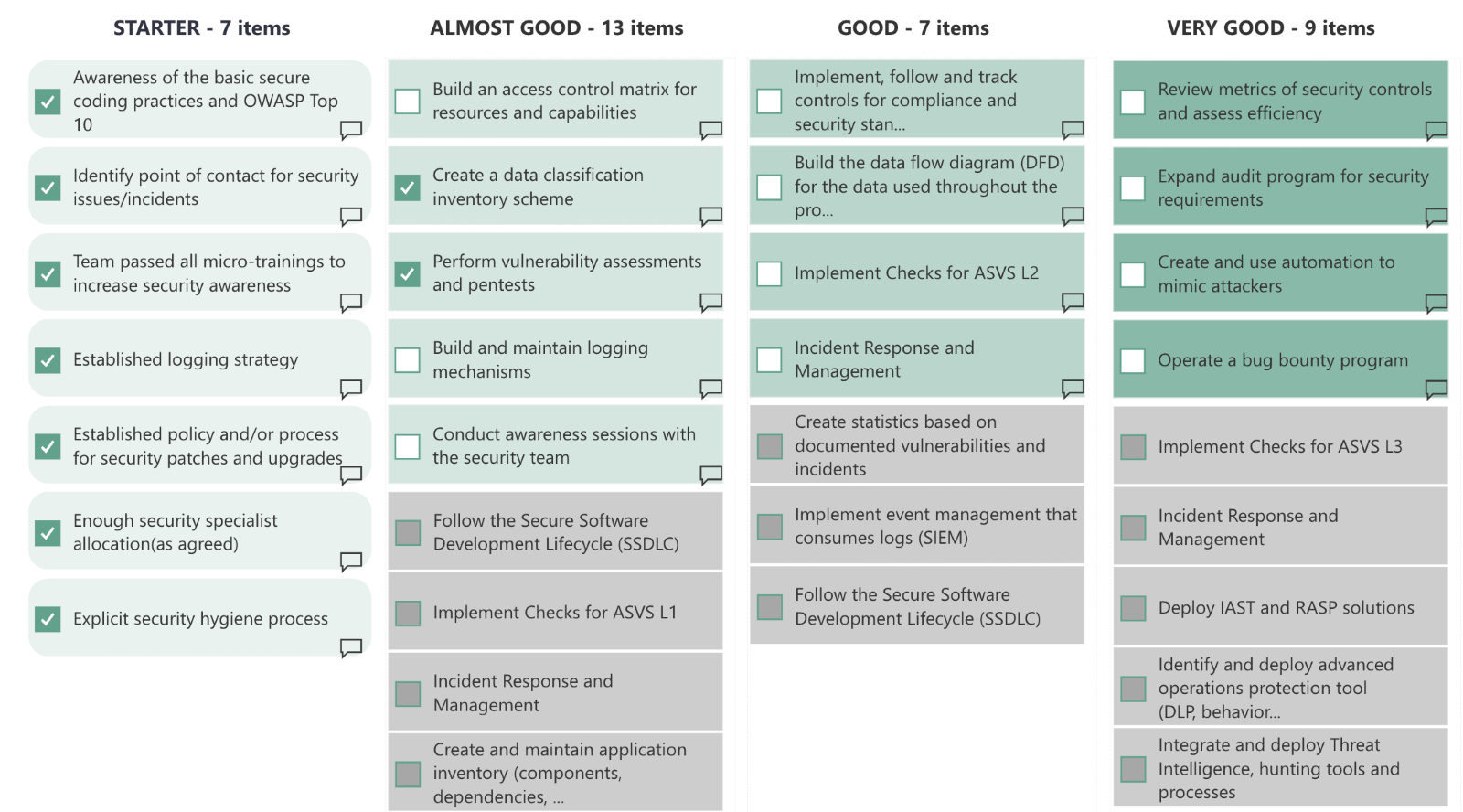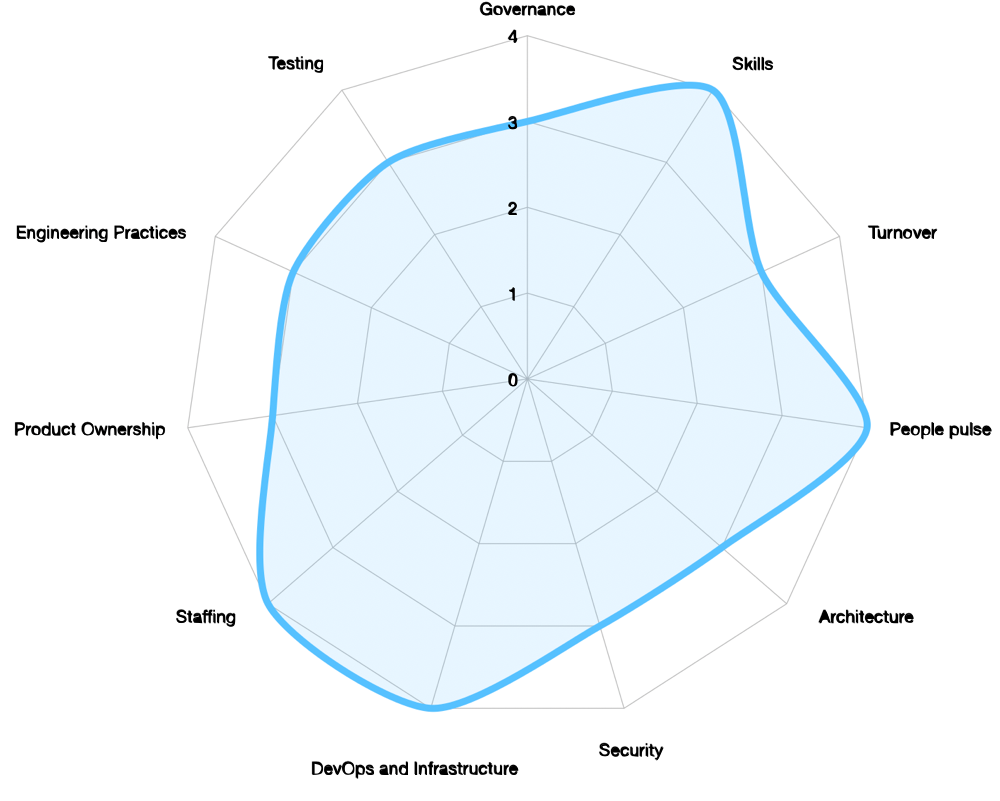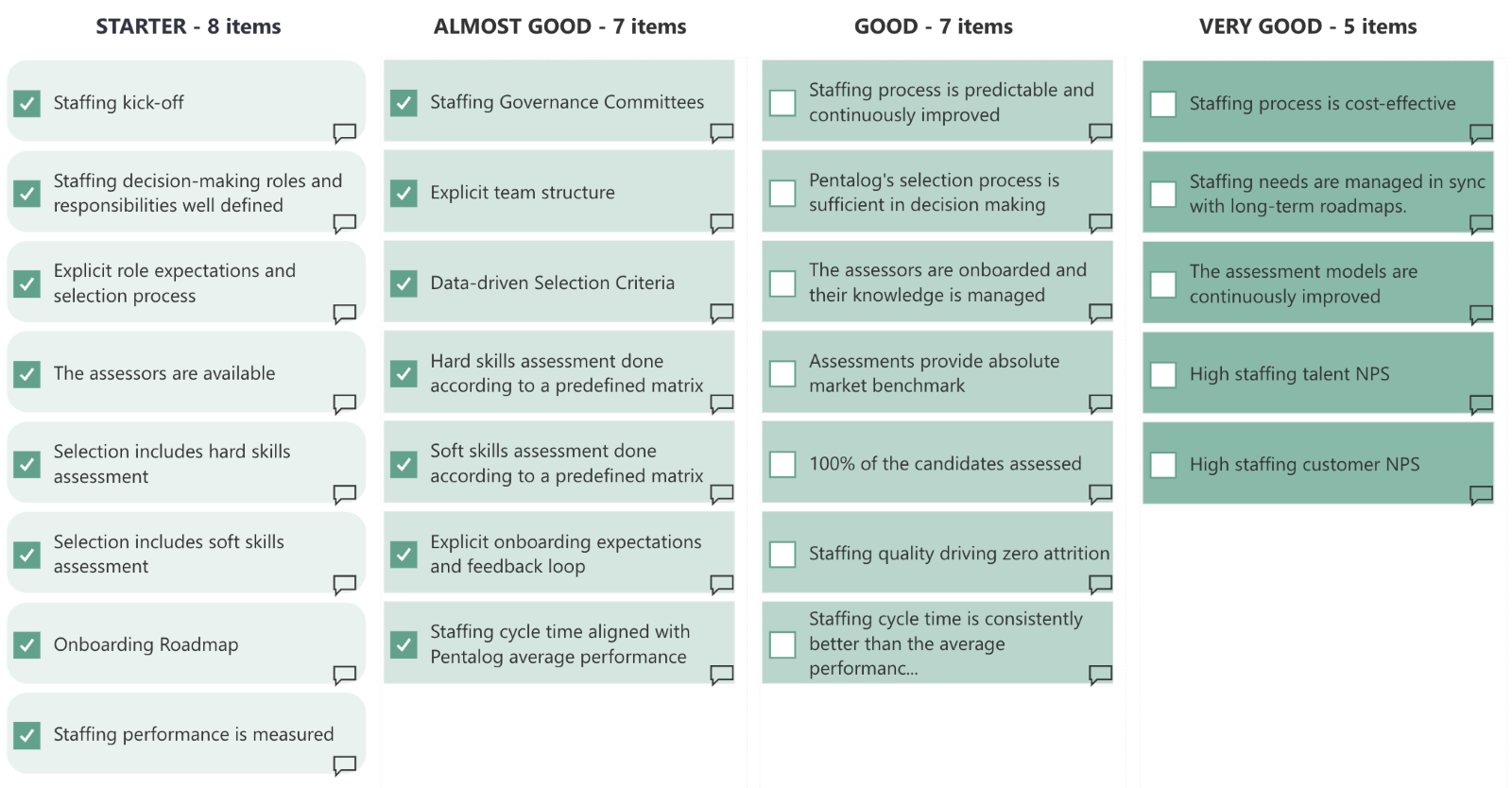Introduction
In the ever-changing landscape of business, having a framework that not only gauges progress but also propels growth is indispensable. Enter Pentalog’s Maturity Models – dynamic tools that have been shaping our journey towards excellence since 2017. This article dives deep into the evolution of these models, tracing their transformation over time and their continuous alignment with the shifting tides of industry best practices.

The Genesis of Our Maturity Models
At the outset, our Maturity Models were born out of the need for a structured approach to assess our status and growth trajectory. With a vision to measure and enhance our capabilities, the initial versions laid the groundwork for a journey of improvement. It has been and continues to be the result of the work of Pentalog’s Technology Office team, under the leadership of our Engineering Managers sub-team. It emerged as a tool that amalgamates industry-leading practices with our extensive application development experience (spanning three decades and encompassing over a thousand projects). This tool is designed to steer teams in the correct direction and facilitate the establishment of effective practice. And of course, the initial versions were simple Excel checklists.

A Dynamic Evolution: Adapting to Realities
Keeping Pace with Industry Trends
As industries evolve, so do the benchmarks for success. Our Maturity Models have been our compass, guiding us through the shifting terrain of technological advancements and changing customer expectations. Regular assessments and updates ensure that we’re not only keeping up but leading the pack. The need for adaptation and enrichment of content can arise both from the industry, as a natural evolution, and from the experience and lessons learned from the projects we work on. The latter proves to be the most valuable, as it comes bundled with the context of a tangible product.

Customization for Context
One size doesn’t fit all. We recognized this early on, which led to the customization of our Maturity Models to fit our unique business context. This adaptability has enabled us to address specific pain points and seize opportunities that generic frameworks might have missed. As a result, our managers today have the flexibility to negotiate an expected level for each collaboration, starting from standardized content. This enables us to explicitly set expectations with each client and move from the abstract towards greater precision.

A GPS for Growth: Navigating with Precision
Imagine having a GPS system that not only guides your journey but also helps you map the best route. Our custom Maturity Applications serve as just that – a GPS system tailor-made for our growth journey. Integrated seamlessly into our day-to-day activities, these applications have revolutionized the way our managers approach projects. By assessing the specific maturity axes—Governance, Skills, Turnover, People Pulse, Architecture, Security, DevOps and Infrastructure, Staffing, Product Ownership, Engineering Practices, and Testing—we can identify strengths, weaknesses, and areas of potential improvement with unparalleled precision.

Collaborative Refinement: A Collective Effort
Harnessing Internal Expertise
Our Maturity Models aren’t just documents; they are a culmination of insights from across our organization. By pooling the expertise of our top specialists, we’ve crafted a holistic representation of our capabilities and growth potential. Furthermore, we didn’t stop at content alone; we aimed to harness the full power of data. Thus, we constructed an application that not only facilitates management but also enables regular measurement of project maturity. So that, we’re able to tap into a treasure trove of data amassed from our previous experiences. This allows us to draw comparisons, extract patterns, and generate valuable contextual propositions that might have otherwise remained hidden.
Starting from the inception phase of a project, our Maturity Applications have become indispensable. They empower us to craft project-specific maturity roadmaps that are not only data-driven but also adaptable to the project’s unique context. This proactive approach ensures that we hit the ground running, armed with insights that align our efforts with anticipated outcomes.

The Managers’ Tool of Choice: A Seamless Integration
Our Maturity Applications aren’t just reserved for specialized teams – they’ve become an integral part of our managers’ daily toolkit. Seamlessly integrated into their workflow, these applications have revolutionized the way decisions are made, offering a comprehensive view of a project’s maturity status and guiding their actions towards optimal results.
Feedback Loops that Fuel Progress
Continuous improvement is in our DNA. Regular feedback loops from teams and stakeholders have provided the fuel for iterative updates. This iterative process ensures that our Maturity Models remain relevant, accurate, and genuinely effective.
Realizing Tangible Benefits
Driving Informed Decision-making
Incorporating Maturity Models into our strategic planning has been a game-changer. By benchmarking against our own progress, we’ve been empowered to make informed decisions that align with our growth objectives. Not only are we aided by these models in making strategic decisions, but our clients also enjoy the same advantage, as they have access to data about their project maturity by default. Because Transparency and visibility are our pillars and values.
Cultivating a Culture of Excellence
Maturity Models have become more than just tools – they’ve become part of our cultural fabric. They encourage a mindset of continuous growth and innovation, propelling us towards industry excellence. By having regular access to project evaluations, our clients can make strategic decisions and construct their own roadmap for maturity growth.

How Incorporating Maturity Models Enhances Technical Governance and the Consequences of Not Doing So
Our Maturity Models can prove invaluable in various scenarios, offering your business the opportunity to achieve growth and establish a robust foundation. Depending on the specific axis under consideration, the associated benefits and risks may fluctuate. However, in a general sense, these models assist organizations in the following ways:
- Enhanced Decision-Making Framework: Through our Maturity Models, we provide a well-structured framework for evaluating growth. This empowers data-driven decision-making, enabling organizations to navigate towards optimal outcomes with a clear understanding of their current standing.
- Optimized Resource Allocation: Our Maturity Models provide precise insights that guide intelligent resource allocation. By channeling efforts towards the most crucial areas, organizations can maximize their return on investments, making their resource utilization highly efficient.
- Cultivating a Culture of Continuous Improvement: At the heart of our Maturity Models lies the cultivation of a culture characterized by perpetual refinement. Regular assessments and adaptations fuel a relentless pursuit of excellence, fostering a commitment to continuous improvement and innovation within the organization.
- Audits and Due Diligence: Our Maturity Models find utility in audit processes, as they offer an objective benchmark for evaluating the product under assessment against comparable products in our database. Furthermore, they factor in industry best practices and standards, ensuring a comprehensive and informed evaluation.
Now, let’s explore the potential risks that your organization might face by ignoring a tool like this:
- Lack of Strategic Orientation: Forgoing the implementation of Maturity Models can leave your organization without a clear roadmap for growth. This absence of guidance can result in a lack of direction, leading to disjointed efforts and a failure to capitalize on potential opportunities.
- Diminished Competitiveness: In the swiftly evolving business landscape, failing to adapt is tantamount to conceding ground. By disregarding Maturity Models, your organization risks remaining stagnant and complacent, eventually leading to a decline in competitiveness against more agile counterparts.
- Overlooking Optimization Prospects: Maturity Models offer structured insights that can be pivotal for process optimization, efficient resource allocation, and adaptation to shifting trends. Not leveraging these insights could cause your organization to overlook valuable opportunities to enhance efficiency, allocate resources more effectively, and stay aligned with industry changes.
- Legal and Security Concerns: Failing to attain a clear understanding of your organization’s present status and the targeted level of maturity could lead to commitments that are detached from reality when dealing with legal or performance-related matters. Aligning business growth objectives with market and industry realities is advisable, rather than fostering a misconception that benefits come without associated costs. This approach ensures an honest representation of possibilities and fosters informed decision-making.
Looking Ahead: The Future of Our Maturity Models
As we stand at the cusp of the future, our Maturity Models continue to evolve. With advancements in data analytics and technology, we envision a dynamic ecosystem that provides real-time insights and predictive capabilities, empowering us to chart a course towards uncharted territories. In the coming times, we intend to further engage with the community and make certain benchmarking tools accessible in a self-service format. So, rest assured, there’s more to look forward to… stay tuned!
Conclusion
The evolution of our Maturity Models mirrors our journey as a company – one of resilience, adaptability, and growth. From their inception to the present, these models have not only measured our progress but have also guided us towards industry-leading practices. As we look ahead, we’re excited to continue this journey, armed with evolving tools that ensure we navigate the path to success with confidence and clarity.


 (9 votes, average: 4.11 out of 5)
(9 votes, average: 4.11 out of 5)







